Most marketers start and end their keyword research with traditional tools. However, Google Trends is a powerful tool to understand keyword popularity over time, create relevant content, and publish them at the right time.
For new brands that are unsure where to begin, Google Trends helps you to:
Identify if your niche is viable Determine the locations to target Choose primary keywords Understand the type of content to publishIt’s a great place to start your research when you’re unsure if your preferred topics and keywords are popular on search engines.
For established brands, Google Trends allows you to:
Stay on top of your competitors Find relevant terms to target Optimize your ad campaigns Create content based on real-time dataAdditionally, it offers a wealth of information that’s often under-utilized by marketing teams.
This guide will show you how to use Google Trends data to find target keywords, create evergreen content, and maximize your marketing budget.
What is Google Trends?
Google Trends shows the frequency of a search term in Google SERPs compared to the total search volume of a website over a defined time period. You can use Google Trends to highlight event-triggered spikes in search volume or for comparative keyword research. You can also use Google trends to find related queries, topics, and demographic insight to understand trends better.
What Can You Do with Google Trends?
Search for a Term or Keyword
Open Google Trends and search for a topic or term. For this example, I’m using “digital marketing agency”.
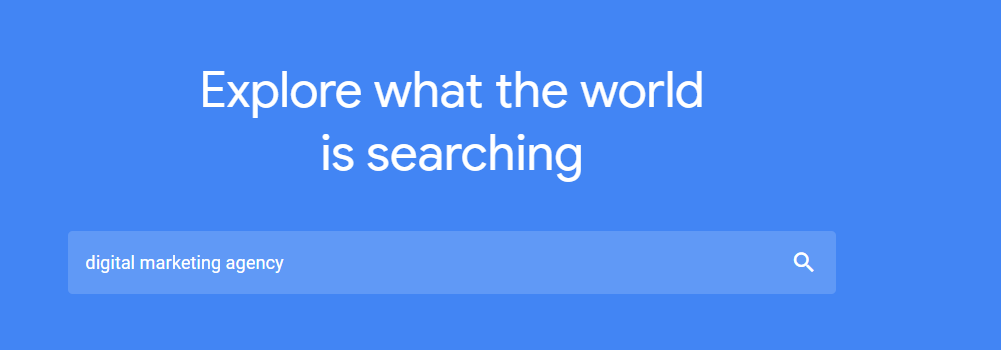
You can filter the results by location, timeline, categories, and type of web search.

I filtered results to the United States and I can see sub-regions with the highest searches for this term.
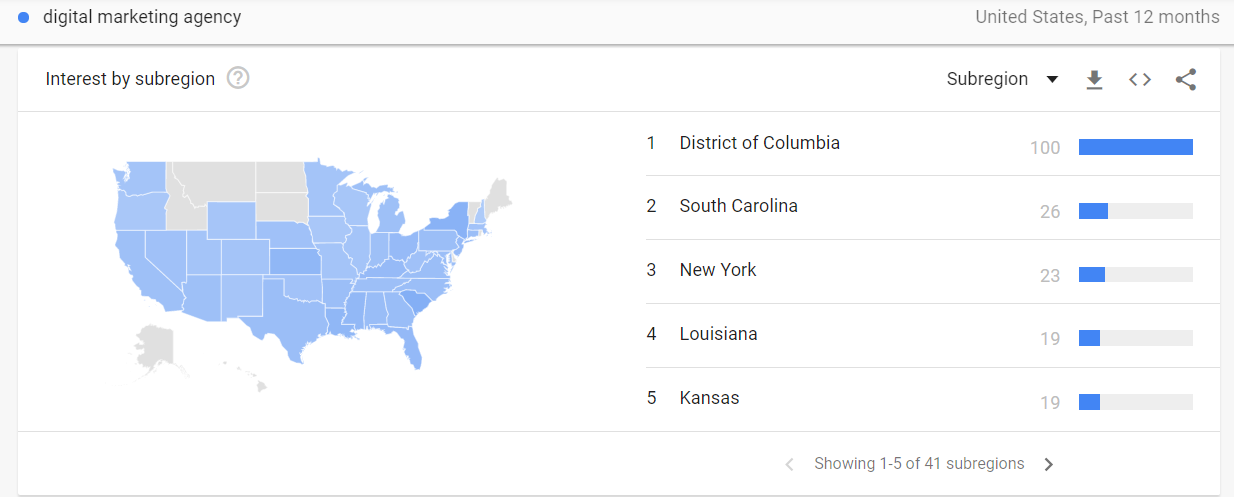
You can also view related queries to optimize in addition to the primary keyword.
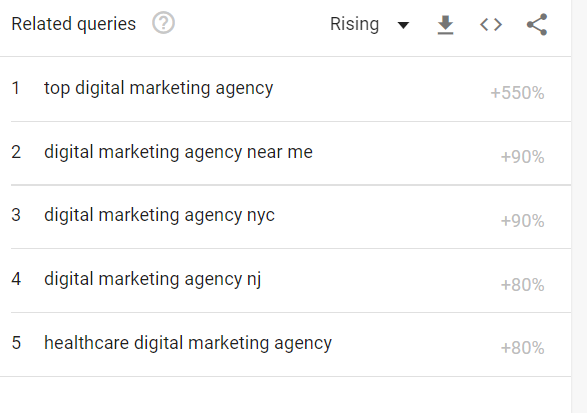
Compare Search Terms
Google Trends allows you to compare up to five groups of terms at once and up to 25 terms in each group. In addition, you can add multiple terms to compare by clicking on + Compare.

The results below feature trends for all three terms I want to compare.
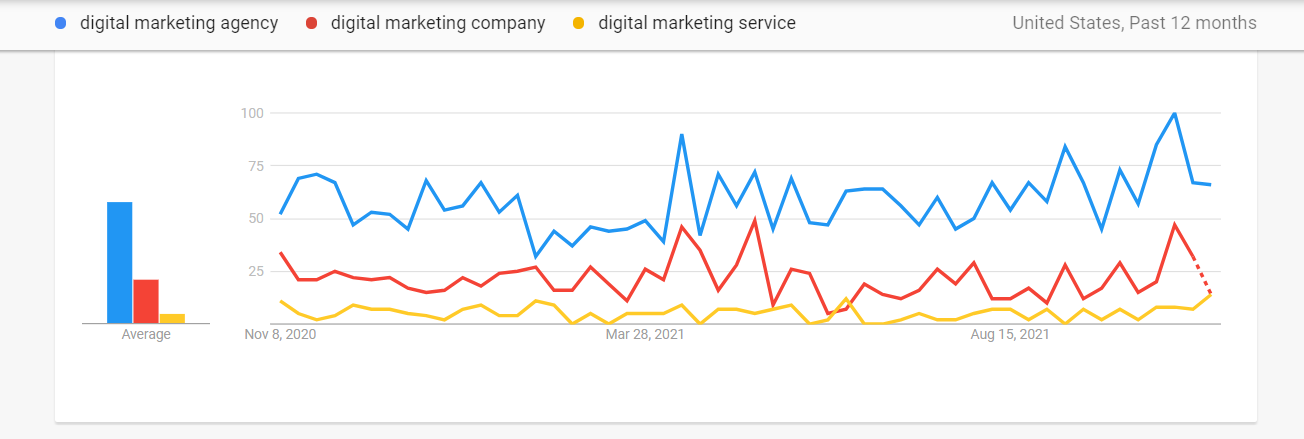
To view data for a specific time frame, hover your mouse over any part of the trend data.

If you are unsure which topic to target, pick the topic with the most searches. In this scenario, that’s "digital marketing agency". Next, optimize your homepage for "digital marketing agency" as the primary keyword and use the other keywords as secondary keywords.
If you want more data on these keywords, go to Semrush Keyword Overview and plug in all the keywords. I’ve added the three terms I compared plus the related terms.
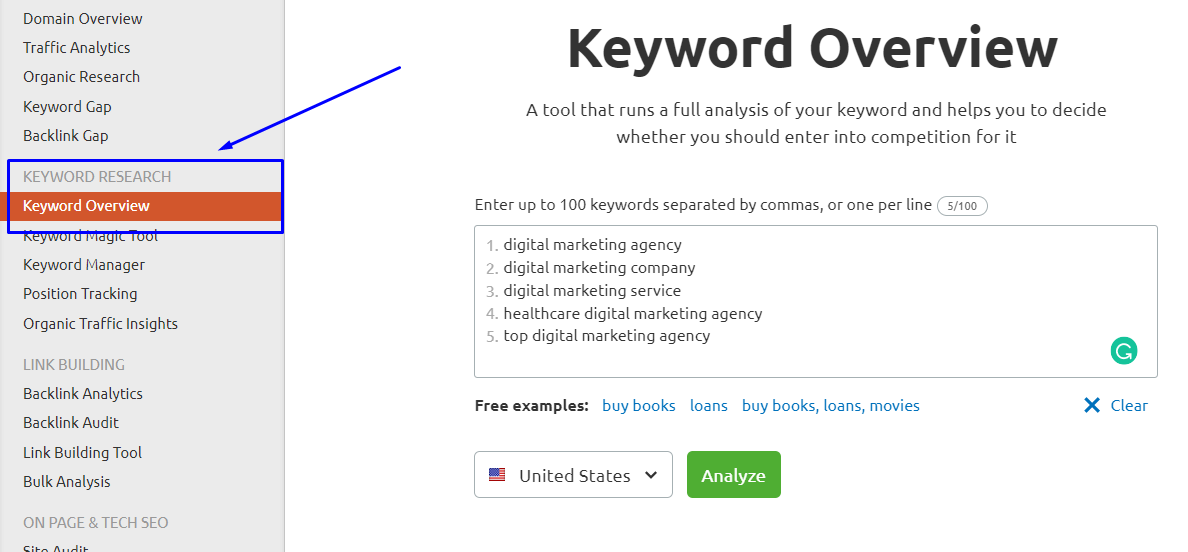
From the results below, I can view information on the search intent behind the keywords (commercial), search volume for the keywords, keyword difficulty, and competition data.
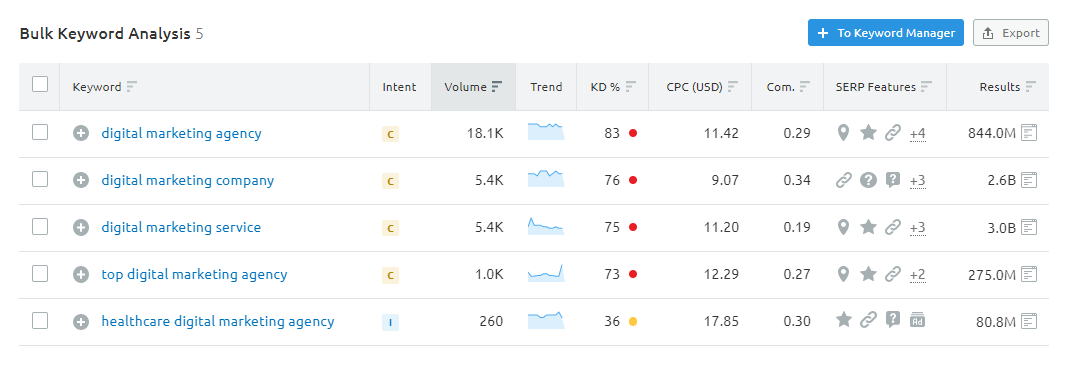
The search intent information is exciting because it tells me what type of content to create if I want to rank for these terms. For commercial keywords, landing pages targeting the search terms would perform better than blog posts that are more suited for informational queries.
So, it’s advisable to use Google Trends to compare search terms to understand trend data in real-time. Then, pair that data with Semrush Keywords Overview to get more details on the search queries.
Find Niche Topics by Region
Do you want to know which regions or sub-regions search for a specific term? You can filter and compare results by region in Google Trends.
For example, I compared "digital marketing agency" and "SEO agency" in California. The results show that “SEO agency” is more popular in Los Angeles and San Francisco sub-regions.
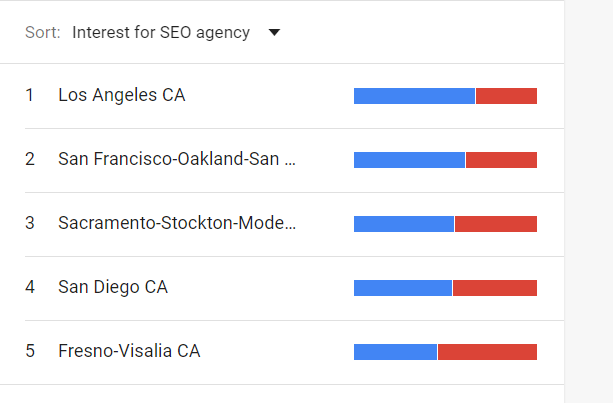
Meanwhile, the term “digital marketing agency” is more popular in Monterey-Salinas and Fresno.
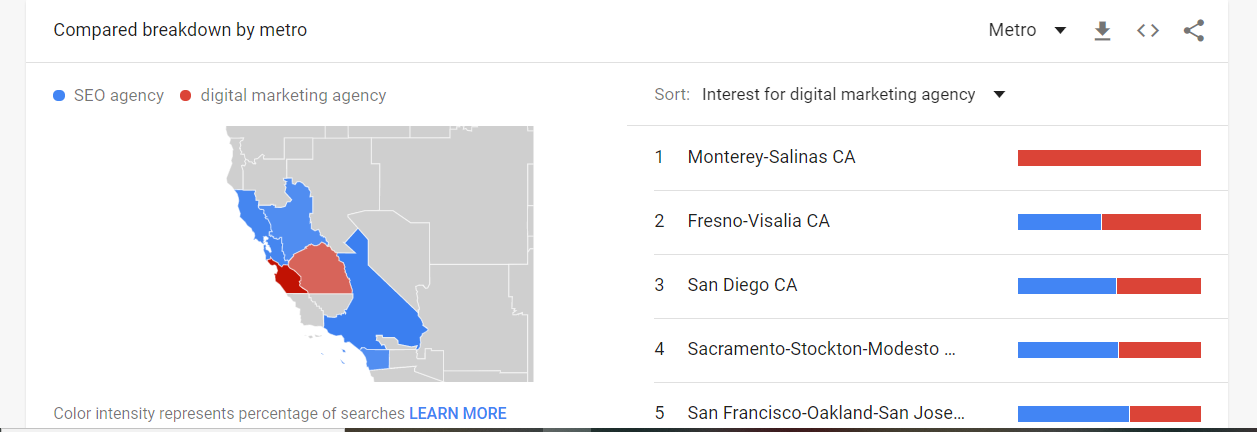
Overall, interest for both terms tends to shift sporadically given the dramatic spikes in search trends.
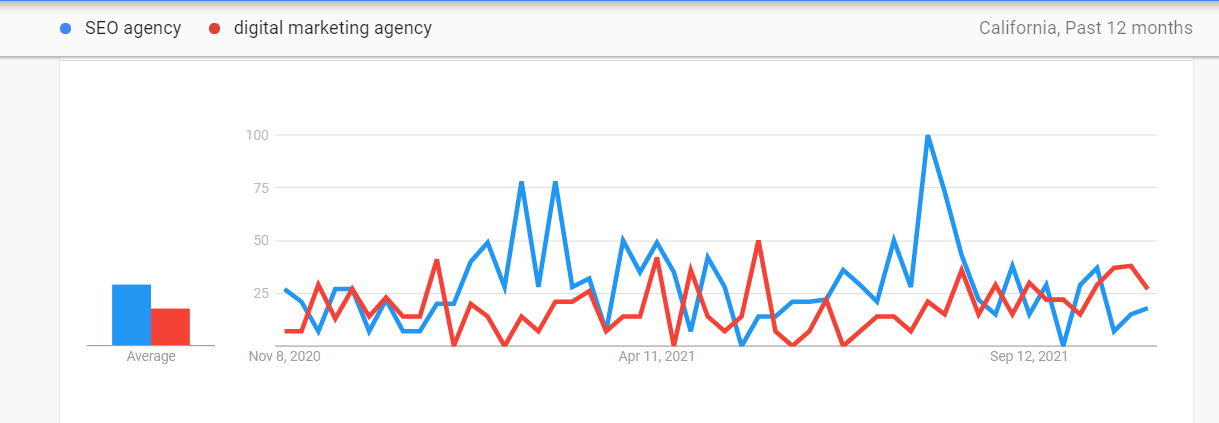
If you offer SEO and digital marketing services, you could use Google Ads or Facebook Ads to target "SEO Agency" in Los Angeles, where the term is more popular. It increases your chances of getting more conversion instead of targeting locations where your preferred search terms are not popular.
Monitor Competitor Performance with Google Trends Compare
You can also use Google Trends to monitor competitors and see how they perform against your brand.
For example, Coke and Pepsi are two of the biggest brands globally, and their rivalry is the stuff of legends. So, I wanted to compare both brands to see which one garnered the most interest since 2004, and not surprisingly, it’s Coke.
However, it started as a keenly contested battle with Pepsi on top for most of 2004. They seemed equally popular in 2005, but Coke pulled ahead in May 2006. After that, Coke kept the momentum going for the most part, except for April 2017, when Pepsi was more famous for a brief period.

I went deeper and took a look at sub-regional searches. Again, Coke is the clear winner throughout the United States except for Colorado and Wyoming, where searches for Pepsi are more popular.

You can compare up to five competitors on Google Trends to see if you’re leading the trend or if your competitors are growing at a faster rate.
If you are leading the trends, capitalize on regions where your brand enjoys popularity to get the most bang for your marketing dollar.
If you’re behind your competitors, conduct competitor analysis with Semrush to understand what your competitors do better. Then, use the data to improve your marketing campaigns.
6 Tips for Using Google Trends to Uncover Insights
Now that we've covered what Google Trends can do, let's talk about how you can use that information to bolster your business.
1. Start with Clear Goals
It’s easier to get the most out of Google Trends data when you have clear goals. For example, if your goal is to maximize ad budget, use regional trends to discover which regions love your brand. Then, increase your budget for these areas to get the most out of your advertising budget.
Conversely, if your goal is to create evergreen content, you’ll avoid creating temporary content that’s only useful when a topic trends briefly.
2. Avoid Temporarily Popular Keywords
Is the new keyword you’re targeting here to stay? Google Trends helps you identify temporarily trending keywords or those steady in the number of searches. I like to narrow the result to the past five years to see repeatable patterns in search trends over a longer period instead of limiting the results to the past 12 months.
I can see visible spikes that tell me if a term is popular around a season, like eggnog during Christmas.

Or if the term only trended for a short time, just like celery juice.

When possible, avoid terms that enjoy popularity for a limited time, such as Easter, the World Cup, or Christmas. These terms won’t generate as many new visitors for your homepage throughout the year compared with consistent trends like "cappuccino".
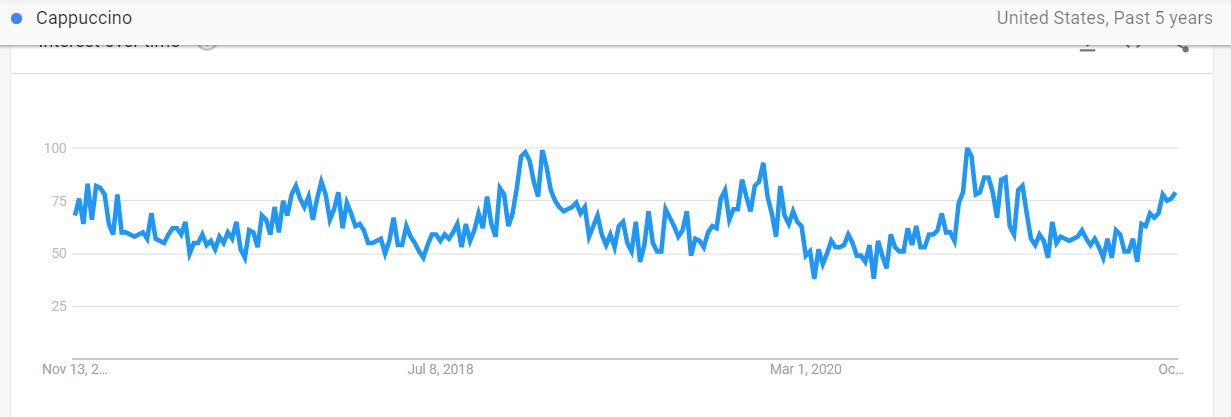
3. Understand Seasonal Interest
One of the essential features of Google Trends is the context it provides for fads. You can uncover if a trend is sustainable and viable, and the visuals allow you to compare how often a term is searched throughout the year and identify when it’s most popular.
You can view when a product or service enjoys the highest searches and the regions where it’s most popular. This means your company hits the right promotion window.
For example, searches for swimsuits usually peak around June every year. If you run a swimsuit company, this is the best time to invest in content and ads that capture the entire user journey.

The dip in searches starts in August and continues to December before a gradual ascent that peaks in June. If you launched a new swimsuit business in October, you might feel discouraged by the lack of traffic, but it gives you sufficient time to create a marketing plan.
During the winter months, consider diversifying your offering to other items targeted to women, such as lingerie, that has a steadier search trend throughout the year.

4. Use Related Topics to Find Competitors
If you’ve decided to sell swimsuits, how do you identify your most popular competitors? Scroll down to the related topics and related queries at the bottom of the trend page. Often, the first-page results of related topics and queries are about popular competitors or those on the verge of breaking out for that search query.

From the data above, we can see that Shein dominates the trend for swimsuits. Other rising brands include Romwe, Fashion Nova, and Cupshe.
It’s a great starting point for competitor research. What keywords are they ranking for? How do they reach their target audience? Use their marketing strategy as inspiration for your brand.
Here’s another example below for the term "lingerie", which Rihanna’s Savage X Fenty dominates.
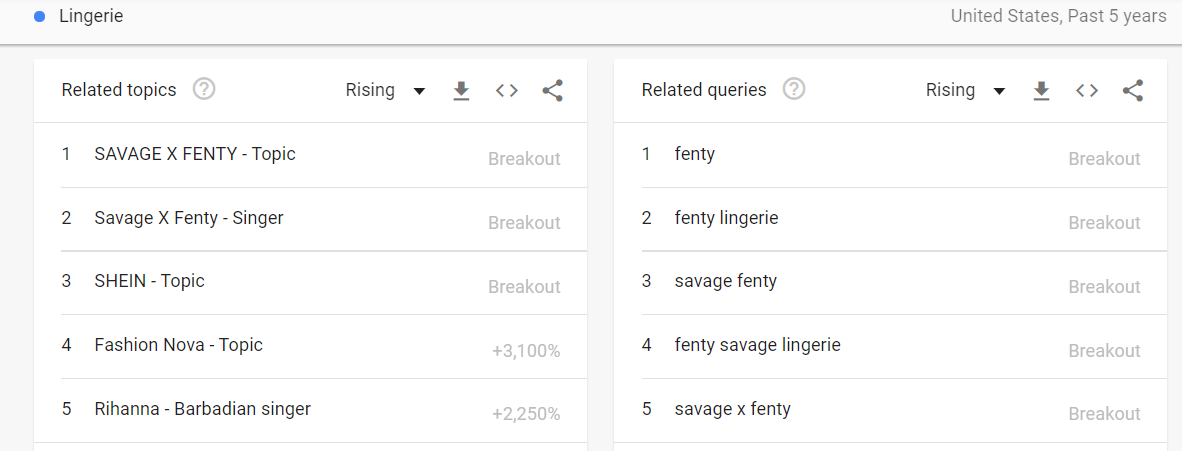
5. Use Google Trends to Find Content Ideas
At this point, you know the product you want to sell, related products to target during the off-season, and your biggest competitors. So, how do you determine what content to create?
If you go past the first page, there’s a goldmine of content ideas to help you get started. From these results, you can create product pages on Nightwear, Bodysuits, and Lingerie Sets as these topics dominate the trend for swimsuits.
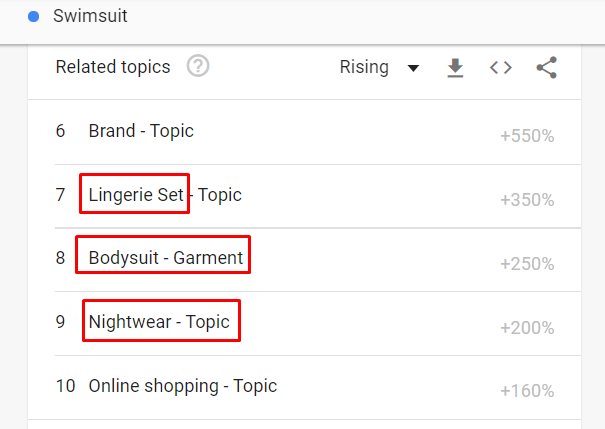
SaaS and tech companies can go one step further with competitor pages targeting alternative keywords. The strategy works because SaaS customers constantly move between software in search of the best tool that meets complex needs.
Here’s a search for "email automation". The related topics show that WooCommerce and ActiveCampaign lead the trend for this term.
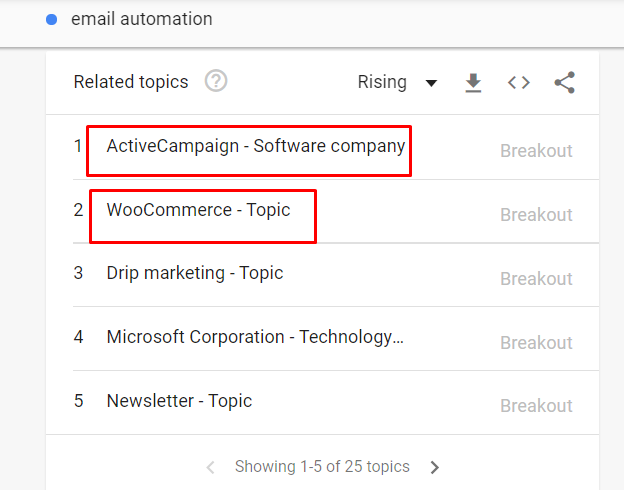
I plugged in “ActiveCampaign alternative” into the Keyword Overview tool to find other related search queries that I could optimize for, and here’s what came up.
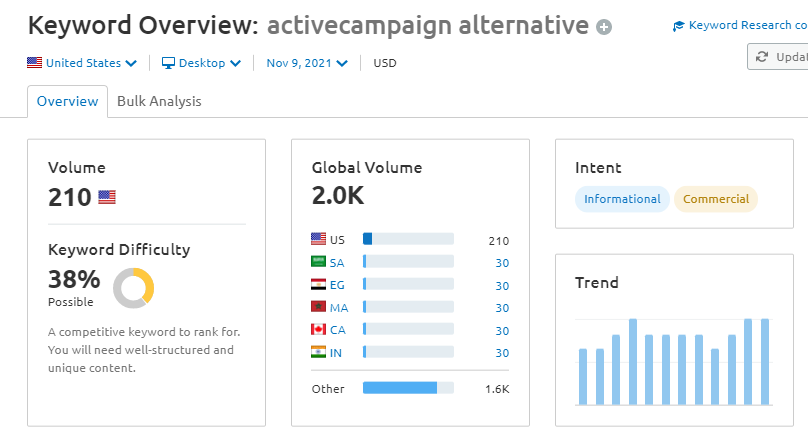
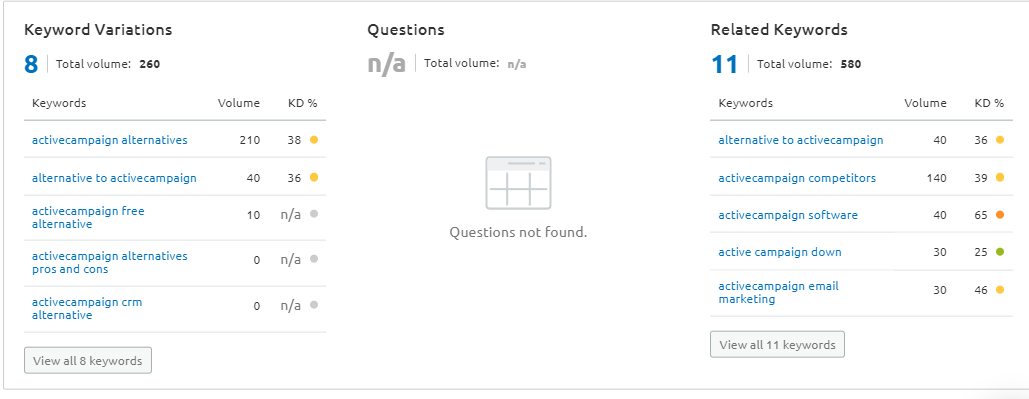
I can use the data from Semrush to optimize the competitor page for these related keywords.
Using the Keyword Magic Tool is another way to come up with content ideas. All you need to do is input a seed keyword of choice, click on the Related filter, and it will provide related keywords and their volume, difficulty, etc.
6. Improve Video SEO
Apart from web results, you can use Google Trends to determine what videos people search for around a topic. Trends show you rising video topics that you can target for content creation. You’ll also gain insight on the best time to create the video and other tags to use for optimization.
Take the term “bitcoin prediction” as an example.

There’s a lot of video content trending for this topic towards the end and beginning of a year. However, due to the volatile nature of bitcoin, the topic also trends when there’s a marked rise or fall of the cryptocurrency.
If you want to create content around bitcoin predictions, you can time it to go live at the start of the new year when people are looking for guidance. Then, use the related queries to optimize your video for SEO.

Concluding Thoughts
Google Trends is an excellent tool for finding trending topics in your niche. In addition, it’s useful to determine the regions that use your product, competitors to keep in view, and the type of content to create.
However, Google Trends is more powerful when you combine it with a keyword research tool like Semrush. Use trends to find topics and Semrush to cross-check trend data and build out your keyword list. This way, you’re getting the entire picture around a trend and targeting terms with significant search volume.
Innovative SEO services
SEO is a patience game; no secret there. We`ll work with you to develop a Search strategy focused on producing increased traffic rankings in as early as 3-months.
A proven Allinclusive. SEO services for measuring, executing, and optimizing for Search Engine success. We say what we do and do what we say.
Our company as Semrush Agency Partner has designed a search engine optimization service that is both ethical and result-driven. We use the latest tools, strategies, and trends to help you move up in the search engines for the right keywords to get noticed by the right audience.
Today, you can schedule a Discovery call with us about your company needs.
Source:





![How to Find Low-Competition Keywords with Semrush [Super Easy]](https://allinclusive.agency/uploads/images/how-to-find-low-competition-keywords-with-semrush-super-easy.svg)